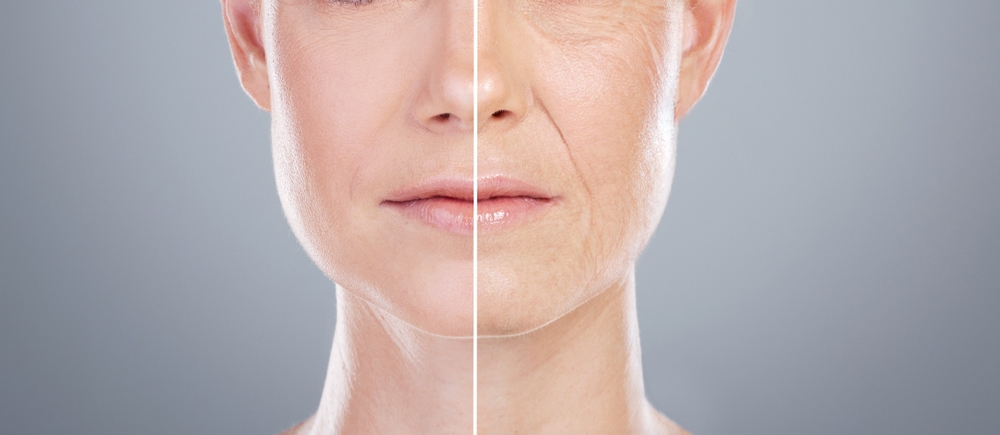Pre-Aging: The New Aesthetic Challenge
Pre-Aging Skin Treatment refers to the premature onset of visible and functional signs of aging in younger individuals, typically between 25-35 years of age. This condition is influenced by genetic, environmental and lifestyle factors that accelerate skin aging before chronological markers would suggest.
What is Pre-Aging?
Skin aging is traditionally associated with chronological progression however a growing number of individuals in their 20’s and 30’s are presenting with dermal deterioration. Dermatologists and aestheticians have termed this condition, pre-aging. This is characterized by loss of elasticity, dull complexion, fine lines and uneven texture.
Causes of Pre-Aging
Intrinsic Factors
Genetic predisposition with reduced collagen and elastin production
Hormonal imbalances with elevation of stress related cortisol levels
Extrinsic Factors
Ultraviolet exposure and photoaging of the skin.
Pollution induced oxidative stress.
Skin care neglect or overuse of harsh chemical treatments.
Blue light chronic exposure.
Lifestyle causes such as poor nutrition, lack of exercise, smoking, use of drugs etc.
Physical Changes Seen in Pre-Aging
- Fine lines, wrinkles and expression wrinkles. These are caused in part due to collagen and elastin degradation and lack of production. This causes less dermal support developing crows’ feet, frown line, and forehead creases.
- Loss of radiance and glow caused by decreased microcirculation and lack of retained moisture. This makes the skin appear dull, less vibrant and fatigued.
- Dull and uneven skin tone caused by accumulation of dead skin cells. This reduced cell turnover leads to a poor dull complexion. The poor cell turnover rate can cause early hyperpigmentation areas and sunspots due to UV exposure and insufficient photoprotection.
- Enlarged pores and early skin texture changes because of sebaceous gland activity and environmental damage. These are found commonly on the nose and cheeks. Skin appears rough due to barrier impairment and decrease desquamation.
- Dryness and dehydration as a result of a compromised skin barrier. This results in tightness, flakiness and increased sensitivity. This is often complicated with harsh skincare products.
- Vascular changes and redness with mild telangiectasias and persistent erythema on the nose and cheek areas due to chronic UV light exposure.
- Periorbital changes are common in pre-aging with dark circles, puffiness and thinning skin in the orbital area.
- Glycation is common with loss of suppleness and an overall yellowish tone. This is a result of advanced glycation especially in individuals with high sugar in their diets or oxidative stress with high cortisol levels.
- Changes in the skin biome and barrier integrity leads to a rosacea like appearance and commonly treated with acne medications which makes the condition worse.
The above are some of the physical signs of pre-aging but not all. They are early biomarkers for significant future aging of the skin and should be delt with promptly to prevent further damage.
Pre-Aging Treatments and Their Mechanisms at the Cellular Level
The goal of treatment of pre-aging is to preserve youthful skin and function, restore homeostasis and prevent and reverse oxidative, inflammatory and structural damage before it becomes irreversible. These are some of the key treatment categories and their cellular mechanisms of action.
Sunscreens and Physical Photo protectants
(eg. Zinc oxide, titanium dioxide, tinosorb)
These agents reduce formation of reactive oxygen species and inflammatory mediators in keratinocytes and fibroblasts. They inhibit metalloproteinase expression which leads to the breakdown of collagen. They also block UVA/UVB radiation preventing the DNA damage caused by this spectrum of light.
Barrier Repair and Moisturizing Agents
(eg. Ceramides, hyaluronic acid, squalene, panthenol)
These agents help rebuild the stratum corneum lipid matrix preventing water loss. Hyaluronic acid binds up to 1000x its weight in water, expanding the extracellular matrix volume and improving hydration. These agents support the skin junction integrity while enhancing keratinocyte function and communication.
Antioxidants
(eg. Vitamin C, Vitamin E, Niacinamide, Resveratrol, Ferulic Acid)
These agents neutralize free radicals such as ROS generated by UV pollution and inflammation which causes DNA damage and lipid peroxidation. Vitamin C stimulates collagen synthesis as a cofactor for prolyl and lysyl hydroxylase in collagen formation. They enhance barrier function by reducing oxidative stress and damage to keratinocytes and fibroblasts. Finally, they downregulate inflammatory cytokines such as IL-6 and TNF-alpha which both cause matrix breakdown.
Retinoids and Retinol Alternatives
(eg. Retinol, tretinoin and bakuchiol)
These compounds bind and upregulate collagen and elastin gene expression in dermal fibroblasts. They normalize the function of the keratinocytes reducing hyper keratinization. They bind to nuclear receptors in skin cells modulating gene transcription. Bakuchiol mimics retinoid activity but also possesses anti-inflammatory and antioxidant effects and does not activate retinoid receptors. This decreases skin dryness and irritation as seen with most retinoids.
Peptides and Growth Factor Mimetics
(eg. Acetyl Dipeptide 31 Amide, Palmitoyl Tripeptide 1, Matrixyl, GHK-Cu)
These are cellular peptides which stimulate fibroblasts to increase collagen synthesis. Peptides reduce matrix metalloproteinases that degrade collagen under oxidative or UV stress. They maintain epidermal integrity by keratinocyte proliferation and promote wound healing. Acetyl Dipeptide 31 Amide modulates neurogenic inflammation reducing cortisol induced cell damage and upregulates stress protective proteins.
Micro needling and Low-Level Laser Light Therapy (LLLT)
Micro needling induces a controlled micro-injury that stimulates the wound healing cascade. In turn, activation of fibroblasts migration and TNF-beta signaling occurs increasing collagen and elastin deposition. Micro needling enhances topical product penetration through the microchannels made in the stratum corneum and below.
LLLT using photo biomodulation by red or near infrared light enhances mitochondrial ATP production in the dermal cells. This increases cytochrome c oxidase activity supporting repair and reducing oxidative stress.
The Power of Acetyl Dipeptide 31 Amide and Bakuchiol
The most recent and studied combination for pre-aging is Acetyl Dipeptide 31 Amide and Bakuchiol. They have synergistic effects in the treatment of this condition.
Acetyl Dipeptide 31 Amide
- Acts on neuromodulator pathways reducing inflammation and cortisol related skin damage.
- Reduces sensory neuron stimulation minimizing redness and sensitivity.
- Increases epidermal stem cell expression.
Bakuchiol
- Stimulates collagen types 1, 3, and 4 expression without binding retinoid receptors.
- Reduces early pigmentation changes by improving melanin dispersion.
- Reduces lipid peroxidation and inflammation in fibroblasts.
Both ingredients, reduce oxidative and inflammatory damage while promoting fibroblastic activity and overall skin homeostasis. These compounds delay the transition from pre-aging to aging skin while preserving youthful appearance and skin structure.
Cellular Benefits of Treating Pre-Aging Early
The treatment of pre-aging works at the cellular level to perform the following:
- Protect against oxidative stress.
- Enhance collagen synthesis and matrix repair.
- Improve barrier function and increase hydration.
- Reduce inflammation and hormonal signaling.
- Promote cell turnover and epidermal regeneration.
The Importance of Early Detection and Treatment
The pre-aging population represents both a challenge and an opportunity to impact the course of skin aging. Early interventions can delay the more advanced stages of this disease. Studies show that more free radicals are generated in younger skin after exposure to agents such as UVA than in older skin. However, younger skin is more responsive to treatments and prevention. Therefore, early detection and therapy is mandatory in this group of individuals to reduce the current epidemic of pre-aging skin.
Studies
Counteracting Skin Aging in Vitro by Phytochemicals
J Cell Mol Med 2025 Apr;29(7): e70530 PMID 40181572
Combined Multilevel Anti-Aging Strategies and Practical Applications of Dermocosmetics in Aesthetic Procedures
J Eur Acad Dermatol 2024 Jul;38 Supp 4:23-35 PMID 38881448
A Scientific Approach to Defining, Evaluating, and Treating Pre-Aging with a Cosmetic Regimen Containing a Novel Cosmetic Peptide, Acetyl Dipeptide-31 Amide
J Drugs Dermatol 2025 May 1;24(5):51181s-14 PMID 40327583
Juventix Solutions for Pre-Aging Skin Treatment
Juventix Regenerative Medical offers the most current treatments, devices and biologics to treat and combat aging of the skin. Juventix Regenerative Medical has topicals such as peptides, exosomes and Privive Serum, which is an advanced skin permeation system.
Juventix Regenerative Medical provides devices such as the Radiance RF and NanoPen for micro needling. The DermaMend Laser for the specific use of therapeutic wavelengths of light is available for various skin applications.
Juventix Regenerative Medical now offers the Apollo Duet which applies electroporation and iontophoresis to drive various serums and platelet rich plasma into the deep tissues without the piercing of the skin.
Juventix Regenerative Medical is a leader in regenerative medical products. From Platelet Rich Plasma to the Apollo Duet, with customer support and professional consultant assistance not seen with other competitors, Juventix is the leader in the regenerative medical field.
RESTORE, REVIVE, REGENERATE – JUVENTIX REGENERATIVE MEDICAL
Dr. Robert McGrath








